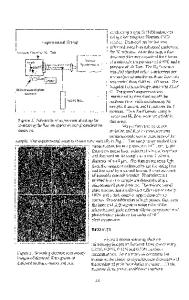Point defect incorporation during diamond chemical vapor deposition
- PDF / 214,467 Bytes
- 8 Pages / 612 x 792 pts (letter) Page_size
- 25 Downloads / 356 Views
MATERIALS RESEARCH
Welcome
Comments
Help
Point defect incorporation during diamond chemical vapor deposition C.C. Battaile and D.J. Srolovitz Materials Science and Engineering, University of Michigan, Ann Arbor, Michigan 48109-2136
J.E. Butler Gas/Surface Dynamics Section, Code 6174, Naval Research Laboratory, Washington, District of Columbia 20375-5342 (Received 11 March 1999; accepted 29 April 1999)
The incorporation of vacancies, H atoms, and sp2 bond defects into single-crystal homoepitaxial (100) (2 × 1)–and (111)-oriented chemical-vapor-deposited diamond was simulated by atomic-scale kinetic Monte Carlo. Simulations were performed for substrate temperatures from 600 to 1200 °C with 0.4% CH4 in the feed gas, and for 0.4–7% CH4 feeds with a substrate temperature of 800 °C. The concentrations of incorporated H atoms increased with increasing substrate temperature and feed gas composition, and sp2 bond trapping increased with increasing feed gas composition. Vacancy concentrations were low under all conditions. The ratio of growth rate to H atom concentration was highest around 800–900°C, and the growth rate to sp2 ratio was maximum around 1% CH4, suggesting that these conditions are ideal for economical diamond growth under simulated conditions.
I. INTRODUCTION
Many of diamond’s technologically promising mechanical, optical, and electronic properties can be dramatically affected by the presence of defects in the solid material. When diamond is chemically deposited from a vapor to produce thin films, these defects are incorporated primarily during the growth process.1 Extended defects like grain boundaries, twins, and dislocations are common in chemical-vapor deposited (CVD) diamond,1–3 as are point defects like vacancies, impurities (e.g., H, N, B), and sp2 (nondiamond) C–C bonds.1,3 Although twins and dislocations are known1,4,5 to form in the diamond lattice as it grows, the details of these processes are not well understood. Point defects can be trapped in the film when material overgrows surface adsorbates or vacant lattice sites. Under typical lowpressure CVD conditions, growth of the thermodynamically stable graphitic C phase is suppressed by the H-promoted growth of sp3-bonded C, although the formation of at least some sp2-bonded material is common. Defects in diamond films can be detected ex situ by a variety of techniques.1 Direct observation of the processes that lead to defect production and incorporation, however, is not possible at present. Diamond is generally deposited at elevated temperatures (700–1200 °C) in a hydrogen plasma at 10–100 torr pressure, and detailed in situ probing of the growth surface or the bulk material in this environment is difficult. Defect incorporation mechanisms that involve chemical processes, such as the J. Mater. Res., Vol. 14, No. 8, Aug 1999
formation and etching of sp2 C bonds, can be studied by use of simple kinetic models of diamond growth.6,7 However, point and extended defect formation processes are inherently atomistic in nature, and a representation o
Data Loading...











